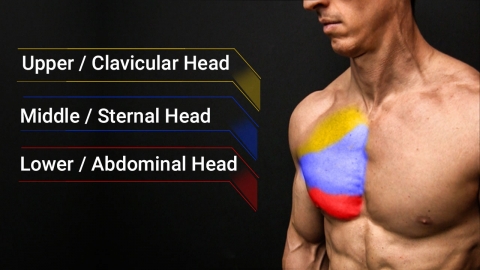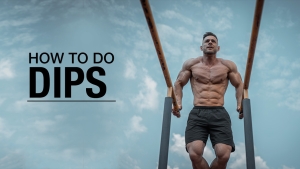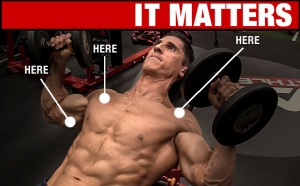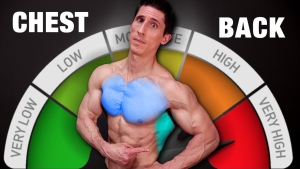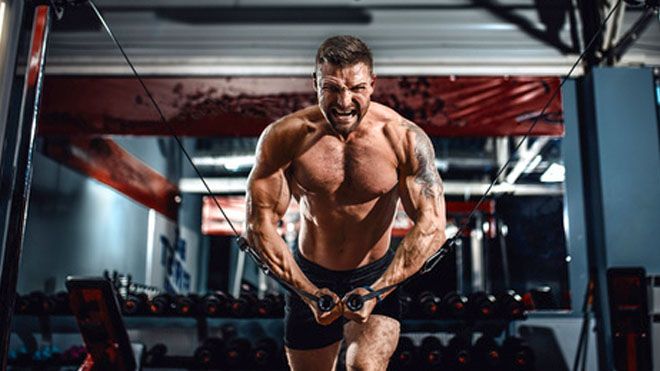
HOW TO DO CABLE CROSSOVERS
Head to any gym and what are the two most popular machines – the ones you literally see a line for during peak hours?
The Lat Pulldown machine and the Cable Crossover machine.
What gives? Why is the Cable Crossover machine always occupied?
Cable Crossovers (or Cable Cross-Over) are one of the best chest exercises, and there are a number of reasons for this. First, they allow you to really isolate your pecs and get a deep stretch in the muscle.
Second, they’re extremely versatile – you can use them to work your lower or upper chest, depending on how you position yourself.
And third, they’re relatively easy to perform and don’t require any fancy equipment or devices beyond a Cable Crossover machine (or something similar like resistance bands or power bands).
If you want to build a massive, strong, and/or defined chest that will make heads turn when you take your shirt off, then you need to start incorporating Cable Crossovers into your workout routine. You won’t be disappointed with the results!
However, there are a number of common Cable Crossovers mistakes that can literally “kill” your gains with this exercise. Read on to find out how to perform the Cable Crossover and how to avoid these common errors.
ANATOMY OF THE CHEST MUSCLES
As always, I want to take a closer look at the muscles that the Cable Crossover exercise activates.
You might be surprised to learn that this one exercise activates more than just the chest muscles.
Here are the muscles that you can target with Cable Crossovers, depending on the arc of motion used.
PECTORALIS MAJOR
The first of the pectoral muscles, the pectoralis major is the largest muscle in this group and is responsible for moving the arm across the body.
PECTORALIS MINOR
The pectoralis minor is a smaller muscle that lies underneath the pectoralis major. It helps to stabilize the shoulder joint.
ANTERIOR DELTOID
RHOMBOIDS
The rhomboids are two small muscles located between the shoulder blades. They help to pull the shoulder blades together and keep them stable during the exercise.
LEVATOR SCAPULAE
The levator scapulae is a small muscle located at the back of the neck. Its primary function is to lift the shoulder blades.
LATISSIMUS DORSI
BENEFITS OF CABLE CROSSOVERS
We know that Cable Crossovers are a great way to work the chest muscles, but that’s not the only reason you should add them to your workout program.
Here are some more of the health benefits (and muscular benefits) of Cable Crossovers:
INCREASES STRENGTH
The cable machine provides constant tension throughout the entire range of motion, allowing you to build strength more efficiently and effectively.
BUILDS MUSCLE MASS
As long as you utilize the proper acute variables for hypertrophy, Cable Crossovers can help to increase lean muscle growth.
IMPROVES SHOULDER MOBILITY
Due to the range of motion that Cable Crossovers involve, they can also help to improve shoulder mobility, making it easier for you to perform everyday activities.
IMPROVES DEFINITION / VASCULARITY
By isolating and focusing on an intense mind-to-muscle connection with the chest muscles, the Cable Cross-Over can help to improve definition and vascularity.
The catch, of course, is that you have to be consistent and dedicated to your workouts to see results.
YOU CAN GO HEAVY OR LIGHT
Continuing with the point above, you can add weight to Cable Crossovers. This allows you to really challenge your chest muscles, alter the level of muscle activation, and see some great results.
This might seem inconsequential but think about Push-Ups where it’s difficult to add weights.
And while you can add weight to the Barbell Bench Press, bench pressing doesn’t allow you to fully enter an optimized range of motion because you can’t take the pecs past center line.
Depending on your fitness goals, you can go lighter or heavier. As I always stress, be sure to be smart about using heavy weight. If you can’t lift it with good form, don’t lift it! Stick with a lighter weight you can confidently lift with perfect form.
YOU CAN DO IT AT HOME (WITH BANDS)
While you can do Cable Crossovers on a traditional cable pulley machine, you can also do a Crossover with resistance bands at home. As long as you anchor them securely in a door jam or above your head, the bands will act like crossover cables.
LOW IMPACT
This exercise is low impact, which means it’s easy on the joints. This is ideal for people who have joint problems or are just starting out with weightlifting.
HOW TO DO THE CABLE CROSSOVER EXERCISE
Before I breakdown how to do the Cable Crossover, I want to drive a point home that applies to all exercises – not just this one:
Guys, it is important that you train in more than one dimension. In fact, I want you training in three dimensions for as many of the exercises in your workout program as you can.
Why do I mean by “train in three dimensions?”
There are three planes of motion that we all move in every day:
- Sagittal: front to back (think forward and backward motions)
- Frontal: side-to-side (think lateral movements)
- Transverse: rotational plane (think of swinging your arms around in a circle)
If you want to take your mediocre exercise and turn it into an elite-level exercise, you should try to incorporate as many planes of motion as you can. But only if it makes sense.
For example, you wouldn’t want to twist the barbell in a circle as you perform a heavy Barbell Bench Press.
Now, how does this apply to the Cable Crossover? How can you get more out of the exercise, making it more of a three-dimensional movement as well as more athletic, explosive, and rewarding?
The Cable Crossover presents us with a better opportunity to incorporate all three planes of motion, ensuring you hit all of those movement goals.
One of the best ways to reap all the benefits of the Cable Crossover exercise is by doing this single-arm version.
DYNAMIC SINGLE-ARM CABLE CROSSOVER

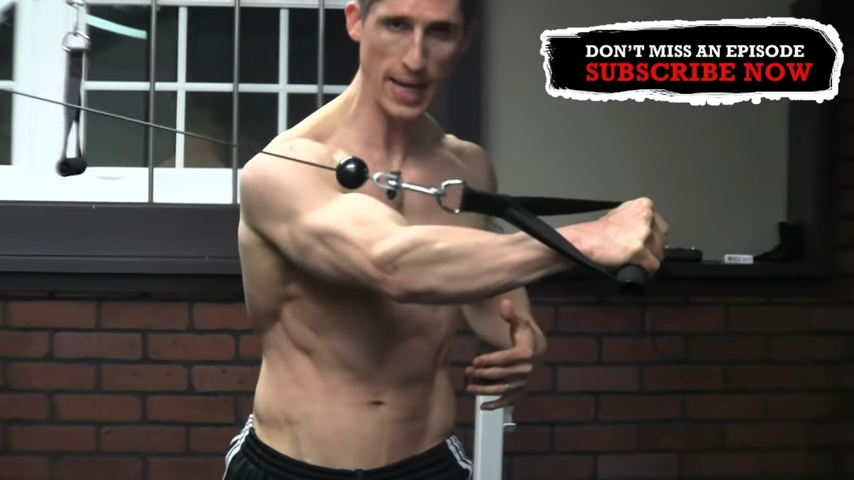
HOW TO DO IT: Begin by setting up whatever Cable Crossover equipment you have access to. If you’re using a Cable Crossover machine, be sure to set-up the high cable cross. If you’re using a resistance band, make sure it’s secured and stable. The attachment point should be at the level of your head or a bit higher. Facing the cable machine, grab the pulley handle on the left side with your right hand. Take a wide stance with your feet, making sure that your toes are pointed toward the cable pulley that you are using. Begin the movement by twisting slightly to your right side then immediately turn across your body while maintaining that wide stance. You’re twisting your torso, not your feet. Think of it like punching across your body. Pause at the top of the movement then slowly bring the arm back. Repeat on the other side once you finish your repetitions on the starting side.
WHAT MAKES IT EFFECTIVE: When you perform the Cable Crossover like this, you don’t have to worry about that big stretch that could hurt your shoulder. As I mentioned above, you’re also hitting all three planes of motion with this exercise. Here’s how: You start with a pullback, providing rotation. Then you move right into a straightaway, which is the sagittal plane. Finally, as you come across your body, providing more rotation, you extend your arm into the frontal plane.
COMMON CABLE CROSSOVER MISTAKES
When doing the Cable Crossover exercise, there are a few mistakes that people often make that can lead to injury or decreased effectiveness of the exercise.
I want to cover those Cable Crossover mistakes and let you know what to do instead.
USING THE ARMS
First, many people focus on using their arms to move the cable handles instead of engaging their chest and core.
Doing so places too much strain on the arms and completely ignores the target muscle: the chest.
TOO HIGH OR TOO LOW
Additionally, some people may not adjust the height of the cables correctly. If they are set too high or too low, you won’t be able to reach full range of motion. This will reduce the amount of muscle engagement with each repetition and won’t provide as much benefit from the exercise.
USING MOMENTUM
Another one of the common Cable Crossover mistakes is swinging your body, replacing conscious effort with momentum.
This momentum can create instability in your posture and increase your risk for injury by overstretching major muscles or tendons. And don’t forget that it completely ignores the target muscle.
LOCKED ELBOWS
Lastly, it’s important to make sure you keep your elbows slightly bent when performing Cable Crossovers as this will help target different muscle groups more effectively than if you were keeping them straight throughout the exercise.
By avoiding these common mistakes when completing Cable Crossovers, you’ll be able to safely achieve maximum results from this exercise!
VARIATIONS OF THE CABLE CROSSOVER
Right now, some of you might be wondering if there’s another Cable Cross-Over variation that I’d recommend – preferably one that isn’t a single-arm variation.
You bet. Guys, if you want another incredible Cable Crossover exercise, I’d recommend the X-Cross.
X CROSS (CABLE CROSSOVER)


HOW TO DO IT: Start by setting up two pulleys – either from a low pulley machine or a cable pulley machine – on either side of you. Take the normal weight you use for High-to-Low Cable Crossovers and decrease it by at least 20% because your focus here will be on form, not heavy weight. From there, grab each handle with your palm facing behind you. This is very important to activate the internal rotators of the shoulder because they will “pre-activate” the chest muscles. Stand with your feet slightly wider than shoulder width apart and your arms held straight and out to your sides. Bring the hands a bit in front of the body and now cross them in front of you right over left. Make sure you’re no higher than waist height. You’ll feel the squeeze right down the center of the pecs and from the bottom up. Now, slowly return to the starting position and repeat, this time crossing the left over the right. Continue to alternate in this fashion.
WHAT MAKES IT EFFECTIVE: The X-Cross provides a new and challenging way to isolate and activate the inner chest. It’s one of my favorite ways to develop inner and lower pecs.
With their versatility and isolated targeting, the pump you can achieve from Cable Crossovers is second-to-none.
Start with lighter weight and focus on perfect form (not to mention that insane burn and pump) before gradually increasing weight over time to ensure steady progress.
Guys, incorporate one or both of these Cable Crossover exercises into your chest program and you will be happy you did.
If you’re looking for a training program that leaves no muscle or area behind, you’ve come to the right place. Check out our ATHLEAN-X programs to see which is the best fit for your goals and fitness level.

- Cable Crossovers are always a fantastic addition to any chest workout. The Cable Crossover exercise primarily targets the pectoralis major and pectoralis minor, but it also hits the anterior deltoid, rhomboids, levator scapulae, and latissimus dorsi.
- The main benefits of Cable Crossovers include strength, lean muscle mass, shoulder mobility, low impact, muscle definition and vascularity, versatility, and convenience at home (using a resistance band cross).
- The variation of the Cable Crossover that will give you the most bang for your buck is the Dynamic Single-Arm Cable Crossover.
- With your right hand, grab ahold of the pulley handle on the left side of the cable machine. Start by slightly twisting over to your right before swiftly pivoting across your body while remaining in a wide stance – think about throwing a punch across your torso!
- If you want a Cable Crossover variation that uses both hands, I recommend the X Cross.
- Start by setting up two pulleys and reduce your normal weight. To kickstart the internal rotators in your shoulders, grab onto each handle with your palms facing behind you. Place your feet slightly wider than shoulder width apart and extend both arms out to either side of you. Move them forward cross the right hand over the left directly ahead of the body. This is essential for engaging those chest muscles!

Jeff Cavaliere M.S.P.T, CSCS
Jeff Cavaliere is a Physical Therapist, Strength Coach and creator of the ATHLEAN-X Training Programs and ATHLEAN-Rx Supplements. He has a Masters in Physical Therapy (MSPT) and has worked as Head Physical Therapist for the New York Mets, as well as training many elite professional athletes in Major League Baseball, NFL, MMA and professional wrestling. His programs produce “next level” achievements in muscle size, strength and performance for professional athletes and anyone looking to build a muscular athletic physique.
















